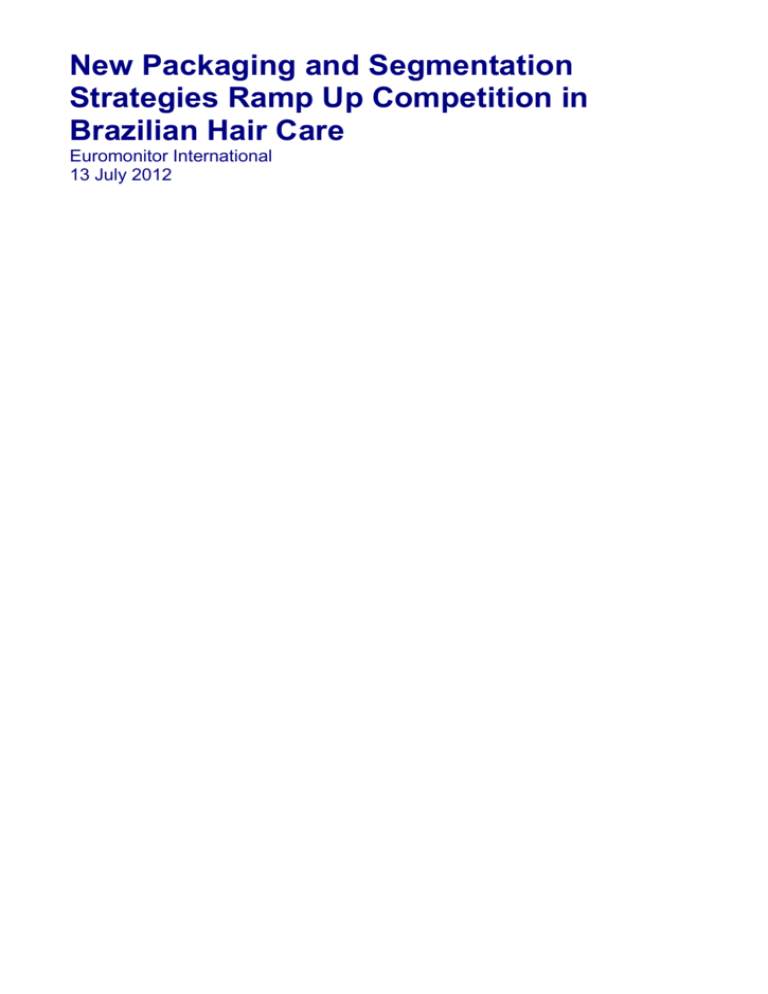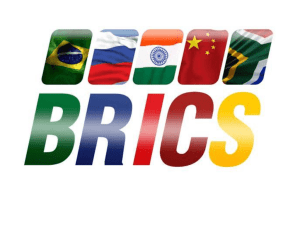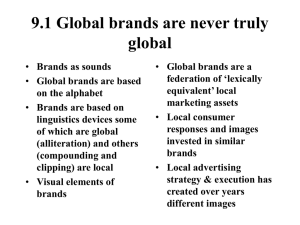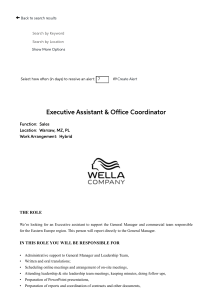New Packaging and Segmentation Strategies
advertisement

New Packaging and Segmentation Strategies Ramp Up Competition in Brazilian Hair Care Euromonitor International 13 July 2012 Brazil's vast number of beauty care salons is testimony to a consumer base with a heavy predilection for looking good, and hair care is top of the agenda. How are leading shampoo and conditioner manufacturers harnessing the retail opportunities, and what defines the key brand battlegrounds? Euromonitor International investigates. The beauty of Brazil There are around 1.5 million beauty salons in Brazil, with a heavy concentration in the southeast. In Rio de Janeiro, for example, it is possible to see as many as 10 salons in the space of only one block. They are as ubiquitous as Havaianas flip-flops and as embedded in the city's heritage as carnival and football. Brazil's strong away-from-home salon culture spills into the retail channel too. Last year, Brazilians spent almost US$6 billion on shampoos and conditioners, which was substantially more than any other country in the world, according to data from Euromonitor International. Japan, the second ranked market, spent US$1 billion less, for example. What is striking about the Brazilian hair care category is, firstly, the plethora of brands on the market (there are estimated to be more than 3,000 brands of shampoo, for example) and, secondly, the low level of brand loyalty. Indeed, it is commonly held among Brazilian women that hair performs better if shampoo and conditioner brands are changed on a regular basis. Brazilians also have a natural propensity to try different brands, a trait that is visible across a wide range of fast moving consumer goods. Weak brand loyalty presents a huge strategic challenge for hair care manufacturers. It means that innovation and new product development are necessarily a focal point of the market. Furthermore, the eclectic ethnic composition of Brazilian society means that hair types vary widely from one region to the next. This goes some way to explaining the vast number of shampoo brands, with small local players often catering for local indigenous hair types. TRESemmé and Wella Pro Series raise the competitive ante Two recent brand launches have defined new segmentation battlegrounds in Brazil's hair care category. Firstly, Unilever's TRESemmé was rolled out in the second half of 2011, following integration of the Alberto-Culver brands. Secondly, Procter & Gamble's Wella Pro Series came on stream at the beginning of June 2012. TRESemmé has proven a big hit in Brazil despite less than a year on the market. It is widely perceived as an affordable premium brand among Brazil's lower-middle-income consumers and, as such, has tapped successfully into aspiration-fuelled purchasing practices. Crucially, it has given Unilever a strong trade up option from its topselling (and economically positioned) Seda line of shampoos and conditioners. TRESemmé ramped up the competition for Procter & Gamble's Pantene Pro-V and L'Oréal's Elsève and Garnier Fructis ranges, helping create what is in effect a new premium tier of salon-in-the-supermarket type brands. Typically, these brands are positioned at double the price of Seda, the market's biggest selling brand at a national level. Brazil's beauty parlour culture has played out well for TRESemmé precisely because of its salon image. The economy segment has now also been given a boost of competitive vitality by the entry earlier this month of Procter & Gamble's Wella Pro Series, which has been positioned as a direct competitor to Unilever's Seda. In 2011, Seda accounted for 18% of shampoo and conditioner sales in Brazil, according to Euromonitor International. And in recent weeks, the price of Seda has been dropping as Unilever looks to beef up the brand's competitive muscle. Given Procter & Gamble's distribution capacity, Wella Pro Series is almost certain to eat into Seda's market share over the next six months. What is important here is the development of a strong economy segment to complement an increasingly high-profile salon-in-the-supermarket (premium) segment. As high-profile brands populate both segments, driven by companies with massive economies of scale, they could start to dilute some of the hair care category's fragmentation. High yield packaging as a means to driving consumer loyalty Of course, given that brand loyalty is famously weak in Brazil's shampoo category, a brand that is popular one month can easily fall out of favour the next. To combat this fickleness in the market, leading players – led by Unilever and Procter & Gamble - are introducing large sized packaging for their flagship hair care brands. The rationale is simple. If a Brazilian woman buys a 750ml bottle of Seda, for example, she is unlikely to need a new brand of shampoo for at least two months. That will drive down the practice of switching between brands, and has potential to boost market share. These high yield packs could also start to eat into the collective market share of the category's plethora of small local brands. By keeping the price of large sized packs competitive, manufacturers are also tapping into value-for-money purchasing patterns. And as Brazil's economic growth slows this year, value for money is set to become more and more important to purchasing criteria. The strategy of high yield packs was first seen in the home care category with Unilever's Omo laundry detergent, which registered a surge in sales over the first half of 2012 on the back of larger containers. The success of Omo in high yield containers effectively paved the way for similar packaging innovation in shampoos and conditioners. What is more, the margins on large sized containers are more attractive than the margins on standard sized bottles, according to industry sources. Micro marketing is the future The brand portfolios of Unilever, Procter & Gamble and L'Oréal are weakest in Brazil's economically empowered (but historically poor) northeast region, as well as in the low-income states of the north and centre-west. In recent years, low-priced small sized packaging has been rolled out in these regions in a bid to attract lower-income consumers, but value-for-money large sized packaging could yet prove more successful. What seems clear is that (barring the development of specific brands for specific regions, which is neither logistically nor commercially viable) the route to stronger penetration outside Brazil's south and southeast regions will be through micro marketing. This will mean developing advertising and promotional campaigns, for example, that are tailored specifically to the consumer profiles of specific states and regions. Brands such as Seda, TRESemmé and Wella Pro Series will be the forerunners of a new trend in micro marketing. The depth and importance of beauty care culture in Brazil is not set to change. If anything, Brazil's new generation of young adults is more body and beauty conscious than the generation of their parents. The wider question relates to whether or not the leading beauty care manufacturers can harness this demand and encourage stronger brand loyalty. The development of more clearly defined segmentation, characterised by the entry of TRESemmé on the premium side and Wella Pro Series on the economy side, together with the drive behind high yield packaging, which gets consumers using the same brand for longer, and the growing emphasis on micro marketing tailored to specific communities are three steps in the right strategic direction. For further insight, please contact Rob Walker, Senior FMCG Analyst, at rob.walker@research7.euromonitor.com









